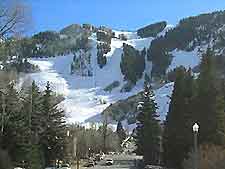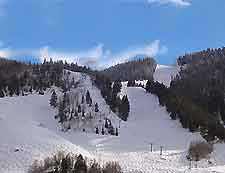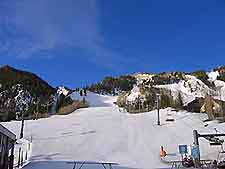Aspen History Facts and Timeline
(Aspen, Colorado - CO, USA)

When the silver mines of Aspen eventually petered out, this picturesque Victorian mountain town reinvented itself as a world-class ski resort.
It set the trend that followed across the American West and dozens of ski areas were created on government forest service land, catering to the rise in popularity of the sport. Today, Aspen is arguably the most glamorous of America's ski resort towns, being as popular with movie stars as it is with hardcore powder hounds.
The Silver Boom
Aspen's history can be traced back to 1879, when a band of hardy miners refused to leave the area in the face of a potential Ute Indian uprising. Originally known as Ute City, this tiny mountain community renamed itself Aspen in 1880. The town hit its peak in 1891, when it became the most productive silver mining area in the US.
In 1893, Aspen was a thriving Victorian town in the middle of the Rocky Mountains. It had two theaters, an opera house, a hospital and several banks. Many of these original Victorian-era buildings and homes still stand, giving the town its charming atmosphere.

The Big Bust
Major problems arose in 1893, when US President Cleveland repealed the Sherman Silver Purchase Act of 1890, the impetus for digging so much silver out of the mountains. Within weeks of the repeal, dozens of Aspen mines closed and thousands of miners found themselves out of luck, abandoning the town in droves.
A Vision of Snow and Skiing
In 1930, only 700 people lived in this once-thriving town. However, the lovely old buildings were still intact and the town continued to see heavy snow each winter. Friedl Pfeifer, a member of the 10th Mountain Division who had trained in the area during WWII, returned after the war and teamed up with Walter Paepcke to establish the Aspen Skiing Corporation in 1946. The rest is Aspen history, as they say.
The town quickly grew into a hot spot for skiing and other alpine recreation. The restored Hotel Jerome reopened in 1947, along with the refurbished Wheeler Opera House - two local landmarks that are still in operation today. Aspen hosted the FIS World Championships in 1950, an event that put it on the global skiing map.

Culture to Match the Recreation
This has been a visionary town from the start. In 1949, it hosted the Goethe Bicentennial Celebration, with Dr. Albert Schweitzer acting as the main speaker. This led to other cultural events and the establishment of permanent organizations like the Aspen Institute, and the Music Festival and School, as well as a wealth of other popular annual festivals. During the 1960s, the skiing history of Aspen expanded with the opening of Buttermilk and the Highlands (1958), followed by the opening of Snowmass (1967).
Aspen remains one of the world's leading centers for alpine research, skiing and unique cultural events. Its primary source of income is tourism, but it's a bustling four-season town and one of the most expensive places to live in America. Celebrities like author Hunter Thompson and singer-songwriter John Denver once called Aspen home, and most visitors wish they could do the same.
 When the silver mines of Aspen eventually petered out, this picturesque Victorian mountain town reinvented itself as a world-class ski resort.
When the silver mines of Aspen eventually petered out, this picturesque Victorian mountain town reinvented itself as a world-class ski resort.
